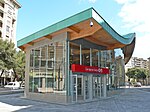La Romareda

Estadio La Romareda [esˈtaðjo ðe la romaˈɾeða] is the home stadium of Real Zaragoza, in Zaragoza. It was inaugurated on 8 September 1957, with a game between Real Zaragoza and CA Osasuna (4–3). The official capacity is 33,608, with an average attendance of around 20,000 for Real Zaragoza matches. Currently, it is the 12th-largest stadium in Spain and the largest in Aragon. The stadium has gone through various upgrades, in 1977 and in 1982, when it was a 1982 FIFA World Cup venue. The stadium was also used for football group matches and a quarterfinal during the 1992 Summer Olympics. It became an all-seater stadium in 1994. The stadium also hosted the 1992-94 FIRA Trophy match between Spain and Romania in 1994. Plans to build a new stadium in Zaragoza have been abandoned. La Romareda was proposed as the Olympic Stadium in Jaca's failed bid for the 2014 Winter Olympics. Works for the enlargement of La Romareda into a 43,000-seat stadium were due to begin on April 17, 2006 and end in time for the Zaragoza Expo of 2008. However, a lawsuit was filed by a political party (PAR), claiming that the enlargement of the stadium would be to the detriment of the population, in order to suspend the planned works. A judge ordered the suspension and the works were put on hold.
Excerpt from the Wikipedia article La Romareda (License: CC BY-SA 3.0, Authors, Images).La Romareda
Calle de Jerusalén, Zaragoza Romareda
Geographical coordinates (GPS) Address External links Nearby Places Show on map
Geographical coordinates (GPS)
| Latitude | Longitude |
|---|---|
| N 41.636666666667 ° | E -0.90194444444444 ° |
Address
Estadio La Romareda
Calle de Jerusalén
50009 Zaragoza, Romareda
Aragon, Spain
Open on Google Maps









